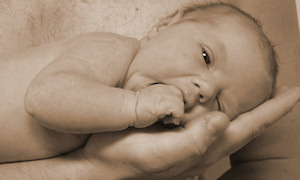I’ve got a history of dating artists, musicians, and scientists. I can’t really explain the reason for this, since I’m not especially knowledgeable about any of these fields. Conversations regarding artistic matters are particularly challenging, for while I can appreciate a good song or a nice painting, remembering the significance of the tritone or what characterized the Romantic Period are tasks that I’m typically not up to. On the other hand, discussions about things like biology usually go a little better, and I tend to come away from them at least slightly less uninformed. It was through such an encounter that the law of biogenesis was explained to me.
Put simply, the law of biogenesis holds that living things can only be produced by other living things. Further, offspring will share the genetic characteristics of their parents. This is the reason why your dog is unlikely to have puppies that can fly or speak English, as cool as that might be. Given the wide acceptance that this rule has within the scientific community, I was a little surprised to read an op-ed piece by political commentator Chris Selley whose title read, “Fetuses are less than human, but more than nothing.” While it’s obvious that fetuses are “more than nothing,” I was perplexed at the claim that they are “less than human.” A human fetus invariably has human DNA, and if carried to term, will enter the world as a human infant rather than as a kitten or a cocker spaniel.
However, I soon discovered Selley wasn’t suggesting that fetuses are somehow biologically non-human. Instead, his contention was that they don’t deserve the same level of legal protection that we normally extend to human beings because there is no absolute consensus regarding the propriety of abortion. Selley concludes that, “When the vast majority of people believe abortion should be legal in some circumstances, the only legal demarcation between medical procedure and murder that makes any sense is the one we have now: Birth.”
If fundamental rights were granted and revoked according to the results of a weekly public opinion poll, then Selley’s rationale might well make sense. Indeed, this is the approach that our society takes when resolving other solemn dilemmas (like who the winner on American Idol should be), so perhaps there’s something to be said for it. But fluctuating poll numbers aside, what else can be said to buttress Mr. Selley’s view? Both logic and consistency seem unsuited to the task.
Physiologically speaking, a newborn infant is almost identical to a nine-month old fetus. Further, a baby’s heart beat and brain waves begin well before birth. Given this continuity, it appears odd that the right to kill an unwanted child should arbitrarily end with his or her birth. This point was not lost on Justice Joanne Veit of the Alberta Court of Queen’s Bench when she refused to give jail time to a woman convicted of killing her baby.
In 2005, Canadian Katrina Effert secretly gave birth in her parents home, after which she strangled her child and threw the corpse into her neighbor’s yard. In her ruling, Justice Veit remarked, “While many Canadians undoubtedly view abortion as a less than ideal solution to unprotected sex and unwanted pregnancy, they generally understand, accept and sympathize with the onerous demands pregnancy and childbirth exact from mothers, especially mothers without support.”
Justice Veit’s opinion is certainly logical: ending a fetus’ life in the third trimester is perfectly legal in Canada, so it would seem inconsistent to harshly punish a woman who choked her baby mere moments after birth. And when you think about it, the grounds for punishing anyone who kills an inconvenient child might start to get a little shaky. Not that all would be bothered by this, of course. As Dr. Kermit Gosnell proved, the concept of a fourth trimester abortion already has a natural constituency.
In America, at least, things like the 14th Amendment, criminal prohibitions on homicide, and Chris Selley’s final arbitrator of truth (public opinion) will hopefully prevent this slide from going too far. Without them, one suspects that the term “less than human” wouldn’t only be applied to those in the womb.







